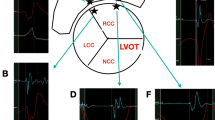Abstract
Objective
This study was conducted to examine the virtual unipolar electrogram configuration of right/left outflow tract (OT) premature ventricular contraction (PVC)/ventricular tachycardia (VT) origins obtained from a non-contact mapping system (NCMS).
Methods
The subjects consisted of 30 patients with OT-PVCs/VT who underwent NCMS-guided ablation. We evaluated the virtual unipolar electrograms of the origin on 3D right ventricular (RV)-OT isochronal maps.
Results
Successful ablation was achieved from the RV in 20 patients (RVOT group), and it failed in 10 (non-RVOT group: including left-sided/pulmonary artery/deep RVOT foci). On the virtual unipolar electrograms, the earliest activation (EA) preceded the QRS onset by 11.2 ± 2.6 ms in the RVOT group and by 7.4 ± 10.5 ms in the non-RVOT group (P = 0.138). The negative slope of the electrogram at the EA site (EA slope5), quantified by the virtual unipolar voltage amplitude 5 ms after the EA onset, was significantly steeper in the RVOT group than in the non-RVOT group (0.66 ± 0.52 mV vs. 0.14 ± 0.17 mV, P = 0.005). Cutoff values for the EA-to-QRS onset time and EA slope5 of ≥8 ms and >0.3 mV, respectively, completely differentiated the RVOT group from the non-RVOT group. A lesser EA slope5 was associated with a greater radiofrequency energy delivery required to terminate RVOT-PVCs/VT.
Conclusions
These demonstrate the importance of the virtual unipolar electrograms from OT-PVC/VT origins obtained with the NCMS. The virtual EA predicts both successful and potentially difficult ablation sites from the RV side.






Similar content being viewed by others
References
Kamakura, S., Shimizu, W., Matsuo, K., Taguchi, A., Suyama, K., Kurita, T., et al. (1998). Localization of optimal ablation site of idiopathic ventricular tachycardia from right and left ventricular outflow tract by body surface ECG. Circulation, 98, 1525–1533.
Ouyang, F., Fotuhi, P., Ho, S. Y., Hebe, J., Volkmer, M., Goya, M., et al. (2002). Repetitive monomorphic ventricular tachycardia originating from the aortic sinus cusp: electrocardiographic characterization for guiding catheter ablation. Journal of the American College of Cardiology, 39, 500–508.
Sekiguchi, Y., Aonuma, K., Takahashi, A., Yamauchi, Y., Hachiya, H., Yokoyama, Y., et al. (2005). Electrocardiographic and electrophysiologic characteristics of ventricular tachycardia originating within the pulmonary artery. Journal of the American College of Cardiology, 45, 887–895.
Obel, O. A., d’Avila, A., Neuzil, P., Saad, E. B., Ruskin, J. N., & Reddy, V. Y. (2006). Ablation of left ventricular epicardial outflow tract tachycardia from the distal great cardiac vein. Journal of the American College of Cardiology, 48, 1813–1817.
Ito, S., Tada, H., Naito, S., Kurosaki, K., Ueda, M., Hoshizaki, H., et al. (2003). Development and validation of an ECG algorithm for identifying the optimal ablation site for idiopathic ventricular outflow tract tachycardia. Journal of Cardiovascular Electrophysiology, 14, 1280–1286.
Zhang, F., Chen, M., Yang, B., Ju, W., Chen, H., Yu, J., et al. (2009). Electrocardiographic algorithm to identify the optimal target ablation site for idiopathic right ventricular outflow tract ventricular premature contraction. Europace, 11, 1214–1220.
Fung, J. W., Chan, H. C., Chan, J. Y., Chan, W. W., Kum, L. C., & Sanderson, J. E. (2003). Ablation of nonsustained or hemodynamically unstable ventricular arrhythmia originating from the right ventricular outflow tract guided by noncontact mapping. Pacing and Clinical Electrophysiology, 26, 1699–1705.
Friedman, P. A., Asirvatham, S. J., Grice, S., Glikson, M., Munger, T. M., Rea, R. F., et al. (2002). Noncontact mapping to guide ablation of right ventricular outflow tract tachycardia. Journal of the American College of Cardiology, 39, 1808–1812.
Storey, J., Iwasa, A., & Feld, G. K. (2002). Left ventricular outflow tract tachycardia originating from the right coronary cusp: identification of location of origin by endocardial noncontact activation mapping from the right ventricular outflow tract. Journal of Cardiovascular Electrophysiology, 13, 1050–1053.
Ribbing, M., Wasmer, K., Mönnig, G., Kirchhof, P., Loh, P., Breithardt, G., et al. (2003). Endocardial mapping of right ventricular outflow tract tachycardia using noncontact activation mapping. Journal of Cardiovascular Electrophysiology, 14, 602–608.
Higa, S., Tai, C. T., Lin, Y. J., Liu, T. Y., Lee, P. C., Huang, J. L., et al. (2004). Focal atrial tachycardia: new insight from noncontact mapping and catheter ablation. Circulation, 109, 84–91.
Narita, S., Miyamoto, K., Tsuchiya, T., Nagamoto, Y., & Yamaguchi, T. (2010). Radiofrequency catheter ablation of atrial tachycardia under navigation using the EnSite array. Circulation Journal, 74, 59–65.
Narita, S., Tsuchiya, T., Ashikaga, K., Ushinohama, H., Tanaka, Y., Yoshinaga, M., et al. (2008). Radiofrequency catheter ablation with the use of a noncontact mapping system for ventricular tachycardia originating from the aortic sinus cusp: a case report. Journal of Arrhythmia, 24, 45–50.
Miyamoto, K., Tsuchiya, T., Narita, S., Nagamoto, Y., Yamaguchi, T., Ando, S. I., et al. (2010). Radiofrequency catheter ablation of ventricular tachyarrhythmia under navigation using EnSite array. Circulation Journal, 25, 1322–1331.
Yamada, T., Murakami, Y., Yoshida, N., Okada, T., Shimizu, T., Toyama, J., et al. (2007). Preferential conduction across the ventricular outflow septum in ventricular arrhythmias originating from the aortic sinus cusp. Journal of the American College of Cardiology, 50, 884–891.
Author information
Authors and Affiliations
Corresponding author
Rights and permissions
About this article
Cite this article
Okumura, Y., Watanabe, I., Nakai, T. et al. A quantitative and qualitative analysis of the virtual unipolar electrograms from non-contact mapping of right or left-sided outflow tract premature ventricular contractions/ventricular tachycardia origins. J Interv Card Electrophysiol 30, 17–25 (2011). https://doi.org/10.1007/s10840-010-9522-4
Received:
Accepted:
Published:
Issue Date:
DOI: https://doi.org/10.1007/s10840-010-9522-4




